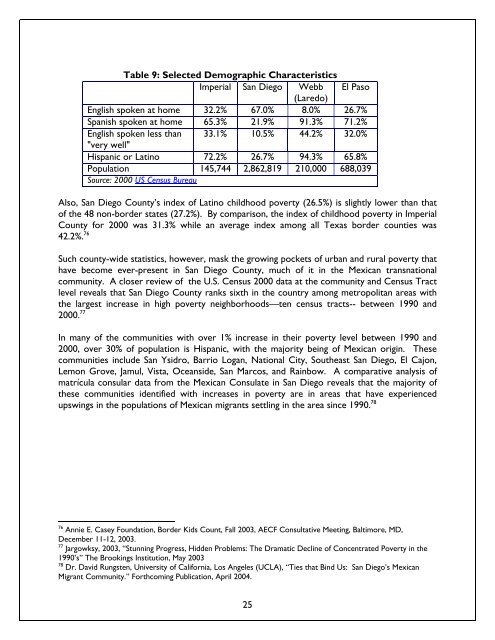Blurred Borders - International Community Foundation
Blurred Borders - International Community Foundation
Blurred Borders - International Community Foundation
You also want an ePaper? Increase the reach of your titles
YUMPU automatically turns print PDFs into web optimized ePapers that Google loves.
Table 9: Selected Demographic Characteristics<br />
Imperial San Diego Webb<br />
(Laredo)<br />
El Paso<br />
English spoken at home 32.2% 67.0% 8.0% 26.7%<br />
Spanish spoken at home 65.3% 21.9% 91.3% 71.2%<br />
English spoken less than 33.1% 10.5% 44.2% 32.0%<br />
"very well"<br />
Hispanic or Latino 72.2% 26.7% 94.3% 65.8%<br />
Population 145,744 2,862,819 210,000 688,039<br />
Source: 2000 US Census Bureau<br />
Also, San Diego County’s index of Latino childhood poverty (26.5%) is slightly lower than that<br />
of the 48 non-border states (27.2%). By comparison, the index of childhood poverty in Imperial<br />
County for 2000 was 31.3% while an average index among all Texas border counties was<br />
42.2%. 76<br />
Such county-wide statistics, however, mask the growing pockets of urban and rural poverty that<br />
have become ever-present in San Diego County, much of it in the Mexican transnational<br />
community. A closer review of the U.S. Census 2000 data at the community and Census Tract<br />
level reveals that San Diego County ranks sixth in the country among metropolitan areas with<br />
the largest increase in high poverty neighborhoods—ten census tracts-- between 1990 and<br />
2000. 77<br />
In many of the communities with over 1% increase in their poverty level between 1990 and<br />
2000, over 30% of population is Hispanic, with the majority being of Mexican origin. These<br />
communities include San Ysidro, Barrio Logan, National City, Southeast San Diego, El Cajon,<br />
Lemon Grove, Jamul, Vista, Oceanside, San Marcos, and Rainbow. A comparative analysis of<br />
matrícula consular data from the Mexican Consulate in San Diego reveals that the majority of<br />
these communities identified with increases in poverty are in areas that have experienced<br />
upswings in the populations of Mexican migrants settling in the area since 1990. 78<br />
76<br />
Annie E. Casey <strong>Foundation</strong>, Border Kids Count, Fall 2003, AECF Consultative Meeting, Baltimore, MD,<br />
December 11-12, 2003.<br />
77<br />
Jargowksy, 2003, “Stunning Progress, Hidden Problems: The Dramatic Decline of Concentrated Poverty in the<br />
1990’s” The Brookings Institution, May 2003<br />
78<br />
Dr. David Rungsten, University of California, Los Angeles (UCLA), “Ties that Bind Us: San Diego’s Mexican<br />
Migrant <strong>Community</strong>.” Forthcoming Publication, April 2004.<br />
25















